| Listing 1 - 9 of 9 |
Sort by
|

ISBN: 3540591796 Year: 1996 Publisher: Berlin Springer
Abstract | Keywords | Export | Availability | Bookmark
 Loading...
Loading...Choose an application
- Reference Manager
- EndNote
- RefWorks (Direct export to RefWorks)
Quantum mechanics. Quantumfield theory --- Quantum field theory. --- Path integrals. --- Théorie quantique des champs --- Intégrales de chemin --- 530.145 --- #dd Sabbe Camiel cfx --- 530.19 --- Quantum theory --- Fundamental functions in general. Potential. Gradient. Intensity. Capacity etc. --- 530.19 Fundamental functions in general. Potential. Gradient. Intensity. Capacity etc. --- 530.145 Quantum theory --- Théorie quantique des champs --- Intégrales de chemin --- Path integrals --- Quantum field theory --- Integrals, Path --- Integrals --- Probabilities --- Statistical physics --- Relativistic quantum field theory --- Field theory (Physics) --- Relativity (Physics) --- Fundamental functions in general. Potential. Gradient. Intensity. Capacity etc
Book
ISBN: 3540523804 0387523804 3642972411 364297239X 9783540523802 Year: 1990 Publisher: Berlin : Springer,
Abstract | Keywords | Export | Availability | Bookmark
 Loading...
Loading...Choose an application
- Reference Manager
- EndNote
- RefWorks (Direct export to RefWorks)
Artificial intelligence. Robotics. Simulation. Graphics --- Computer architecture. Operating systems --- Neural networks (Computer science) --- Models, Neurological. --- Nervous System. --- Systèmes, Conception de --- System design --- Nerve Net. --- #TELE:SISTA --- Artificial neural networks --- Nets, Neural (Computer science) --- Networks, Neural (Computer science) --- Neural nets (Computer science) --- Artificial intelligence --- Natural computation --- Soft computing --- Neural Networks (Anatomic) --- Nerve Nets --- Net, Nerve --- Nets, Nerve --- Network, Neural (Anatomic) --- Networks, Neural (Anatomic) --- Neural Network (Anatomic) --- Model, Neurological --- Neurologic Model --- Neurological Model --- Neurological Models --- Neurologic Models --- Model, Neurologic --- Models, Neurologic --- Systèmes, Conception de. --- Models, Neurological --- Nerve Net --- Systèmes, Conception de.
Multi
ISBN: 9783540875611 Year: 2009 Publisher: Berlin, Heidelberg Springer Berlin Heidelberg
Abstract | Keywords | Export | Availability | Bookmark
 Loading...
Loading...Choose an application
- Reference Manager
- EndNote
- RefWorks (Direct export to RefWorks)
We are pleased by the positive resonance of our book which now necessitates a fourth edition. We have used this opportunity to implement corrections of misprints and amendments at several places, and to extend and improve the discussion of many of the exercises and examples. We hope that our presentation of the method of equivalent photons (Example 3. 17), the form factor of the electron (Example 5. 7), the infrared catastrophe (Example 5. 8) and the energy shift of atomic levels (Example 5. 9)arenow even better to understand. The new Exercise 5. 10 shows in detail how to arrive at the non-relativistic limit for the calculation of form factors. Moreover, we have brought up-to-date the Biographical Notes about physicists who have contributed to the dev- opment of quantum electrodynamics, and references to experimental tests of the t- ory. For example, there has been recent progress in the determination of the electric and magnetic form factors of the proton (discussed in Exercise 3. 5 on the Rosenbluth formula) and the Lamb shift of high-Z atoms (discussed in Example 5. 9 on the energy shift of atomic levels), while the experimental veri cation of the birefringence of the QED vacuum in a strong magnetic eld (Example 7. 8) remains unsettled and is a topic of active ongoing research.
Quantum mechanics. Quantumfield theory --- Elementary particles --- Computer. Automation --- computergestuurd meten --- elementaire deeltjes --- quantumfysica --- kwantumleer

ISBN: 3540580921 0387580921 Year: 1994 Publisher: Berlin : Springer,
Abstract | Keywords | Export | Availability | Bookmark
 Loading...
Loading...Choose an application
- Reference Manager
- EndNote
- RefWorks (Direct export to RefWorks)
Elementary particles --- Quantum mechanics. Quantumfield theory --- Electromagnetism. Ferromagnetism --- Quantum electrodynamics --- Electrodynamique quantique --- Problems, exercises, etc --- #dd Sabbe Camiel cfx --- 530.19 --- Fundamental functions in general. Potential. Gradient. Intensity. Capacity etc. --- Quantum electrodynamics. --- Problems, exercises, etc. --- 530.19 Fundamental functions in general. Potential. Gradient. Intensity. Capacity etc.

ISBN: 3540602070 3642577601 Year: 1995 Publisher: Berlin : Springer,
Abstract | Keywords | Export | Availability | Bookmark
 Loading...
Loading...Choose an application
- Reference Manager
- EndNote
- RefWorks (Direct export to RefWorks)
Book
ISBN: 3540875603 3540875611 9783540875604 Year: 2008 Publisher: New York: Springer,
Abstract | Keywords | Export | Availability | Bookmark
 Loading...
Loading...Choose an application
- Reference Manager
- EndNote
- RefWorks (Direct export to RefWorks)
We are pleased by the positive resonance of our book which now necessitates a fourth edition. We have used this opportunity to implement corrections of misprints and amendments at several places, and to extend and improve the discussion of many of the exercises and examples. We hope that our presentation of the method of equivalent photons (Example 3. 17), the form factor of the electron (Example 5. 7), the infrared catastrophe (Example 5. 8) and the energy shift of atomic levels (Example 5. 9)arenow even better to understand. The new Exercise 5. 10 shows in detail how to arrive at the non-relativistic limit for the calculation of form factors. Moreover, we have brought up-to-date the Biographical Notes about physicists who have contributed to the dev- opment of quantum electrodynamics, and references to experimental tests of the t- ory. For example, there has been recent progress in the determination of the electric and magnetic form factors of the proton (discussed in Exercise 3. 5 on the Rosenbluth formula) and the Lamb shift of high-Z atoms (discussed in Example 5. 9 on the energy shift of atomic levels), while the experimental veri cation of the birefringence of the QED vacuum in a strong magnetic eld (Example 7. 8) remains unsettled and is a topic of active ongoing research.
Electronic books. -- local. --- Quantum electrodynamics -- Problems, exercises, etc. --- Quantum electrodynamics. --- Quantum electrodynamics --- Electricity & Magnetism --- Physics --- Physical Sciences & Mathematics --- Electrodynamics, Quantum --- QED (Physics) --- Physics. --- Quantum physics. --- Elementary particles (Physics). --- Quantum field theory. --- Quantum computers. --- Spintronics. --- Quantum Information Technology, Spintronics. --- Quantum Physics. --- Elementary Particles, Quantum Field Theory. --- Quantum field theory --- Schwinger action principle --- Quantum theory. --- Quantum dynamics --- Quantum mechanics --- Quantum physics --- Mechanics --- Thermodynamics --- deeltjes. --- computer techniques. --- computertechnieken. --- Computers --- Relativistic quantum field theory --- Field theory (Physics) --- Quantum theory --- Relativity (Physics) --- Elementary particles (Physics) --- High energy physics --- Nuclear particles --- Nucleons --- Nuclear physics --- Fluxtronics --- Magnetoelectronics --- Spin electronics --- Spinelectronics --- Microelectronics --- Nanotechnology --- Quantum electrodynamics - Problems, exercises, etc --- Particles (Nuclear physics)
Book
ISBN: 9783540875611 Year: 2009 Publisher: Berlin Heidelberg Springer Berlin Heidelberg
Abstract | Keywords | Export | Availability | Bookmark
 Loading...
Loading...Choose an application
- Reference Manager
- EndNote
- RefWorks (Direct export to RefWorks)
We are pleased by the positive resonance of our book which now necessitates a fourth edition. We have used this opportunity to implement corrections of misprints and amendments at several places, and to extend and improve the discussion of many of the exercises and examples. We hope that our presentation of the method of equivalent photons (Example 3. 17), the form factor of the electron (Example 5. 7), the infrared catastrophe (Example 5. 8) and the energy shift of atomic levels (Example 5. 9)arenow even better to understand. The new Exercise 5. 10 shows in detail how to arrive at the non-relativistic limit for the calculation of form factors. Moreover, we have brought up-to-date the Biographical Notes about physicists who have contributed to the dev- opment of quantum electrodynamics, and references to experimental tests of the t- ory. For example, there has been recent progress in the determination of the electric and magnetic form factors of the proton (discussed in Exercise 3. 5 on the Rosenbluth formula) and the Lamb shift of high-Z atoms (discussed in Example 5. 9 on the energy shift of atomic levels), while the experimental veri cation of the birefringence of the QED vacuum in a strong magnetic eld (Example 7. 8) remains unsettled and is a topic of active ongoing research.
Quantum mechanics. Quantumfield theory --- Elementary particles --- Computer. Automation --- computergestuurd meten --- elementaire deeltjes --- quantumfysica --- kwantumleer
Book
Year: 1954 Publisher: Leipzig Barth
Abstract | Keywords | Export | Availability | Bookmark
 Loading...
Loading...Choose an application
- Reference Manager
- EndNote
- RefWorks (Direct export to RefWorks)


ISBN: 1402024452 Year: 2004 Publisher: Dordrecht ; Boston ; London Brussels Kluwer Academic Publishers NATO Scientific Affairs Division
Abstract | Keywords | Export | Availability | Bookmark
 Loading...
Loading...Choose an application
- Reference Manager
- EndNote
- RefWorks (Direct export to RefWorks)
| Listing 1 - 9 of 9 |
Sort by
|

 Search
Search Feedback
Feedback About UniCat
About UniCat  Help
Help News
News